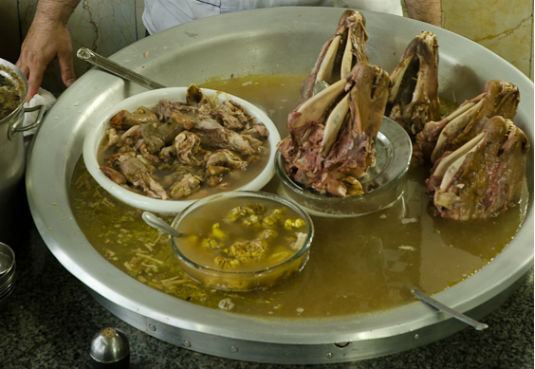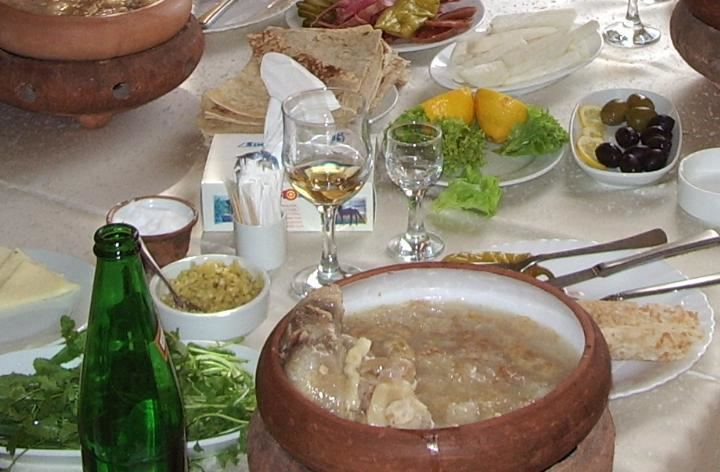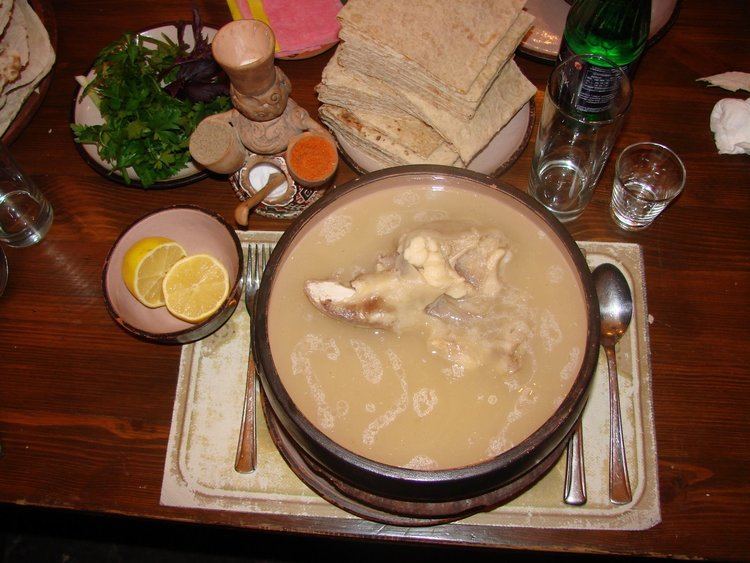 | ||
Similar Tripe soups, Kokoretsi, Dolma, Abgoosht, Chorba | ||
Pacha (Persian: پاچه, Albanian: paçe, Arabic: باجة, Bosnian: pače, Bulgarian: пача), khash (Armenian: խաշ, Azerbaijani: xaş, Georgian: ხაში), kalleh pacheh (Persian: کله پاچه, Turkish: kelle paça), or kakaj šürpi (Chuvash: какай шÿрпи) is a dish of boiled cow or sheep's feet and/or head, although other cow parts, such as the brain, head and stomach (tripe) may also be used. It is a traditional dish in Albania, Armenia, Azerbaijan, Bosnia and Herzegovina, Bulgaria, Georgia, Iran, Iraq, Mongolia, and Turkey.
Contents

Etymology

The Persian word pacheh, literally means "trotter". The Persian name kalleh pacheh literally translates as head and trotter, which are the central ingredients in a variant of this dish. The name khash originates from the Armenian verb khashél (Armenian: խաշել), which means "to boil." Besides, the Armenian root "khashn" (Armenian: խաշն) well testified in early medieval records means "a herd of sheep or goats" Hrachia Adjarian Armenian Etymological Dictionary, v. 2, 1973, page 333</ref>.The dish, initially called khashoy, is mentioned by a number of medieval Armenian authors, e.g. Grigor Magistros (11th century), Mkhitar Heratsi (12th century), Yesayi Nchetsi (13th century), etc.
In the Caucasus
Khash is a purist meal with great parsimony in ingredients. The feet are depilated, cleaned, kept in cold water in order to get rid of bad smell, and boiled in water all night long, until the water has become a thick broth and the meat has separated from the bones. No salt or spices are added during the boiling process. The dish is served hot. One may add salt, garlic, lemon juice, or vinegar according to one's tastes. Dried lavash is often crumbled into the broth to add substance. Khash is generally served with a variety of other foods, such as hot green and yellow peppers, pickles, radishes, cheese, and fresh greens such as cress. The meal is almost always accompanied by vodka (preferably mulberry vodka) and mineral water.
In medieval Armenian medical textbook Relief of Fevers (1184) khash was described as a dish with healing properties, e.g., against snuffle; it was recommended to eat it while drinking wine. In case of ailment khash from the legs of yeanling was advised.
Formerly a nutritious winter food, it is now considered a delicacy, and is enjoyed as a festive winter meal. Modern-day convention in Armenia dictates that it should be consumed during the month that has an 'r' in its name, thus excluding May, June, July, and August (month names in Armenian are derivatives of the Latin names). No such restriction on khash consumption exists in Azerbaijan or Georgia.
In the Caucasus, Khash is often seen as a food to be consumed in the mornings after a party as it is known to battle hangovers (especially by men) and eaten with a "hair of the dog" vodka chaser.
There is much ritual involved in khash parties. Many participants abstain from eating the previous evening, and insist upon using only their hands to consume the unusual (and often unwieldy) meal. Because of the potency and strong smell of the meal, and because it is eaten early in the mornings and so often enjoyed in conjunction with alcohol, khash is usually served on the weekend or on holidays.
In Iran
Kale pache or kaleh pacheh is a version of pâcha made with a sheep's entire head and its hooves with the brain still in the head. The dish is traditional to Azerbaijan and Iran. Usually consumed as a breakfast soup, it includes lamb's head (including brain, eyes and tongues) as well as hooves, and is seasoned with lemon and cinnamon.
To prepare kaleh pacheh, the heads and feet of sheep are collected, cooked and treated as per the recipe.
Kaleh pacheh is almost always only served from three in the morning until sometime after dawn, and specialty restaurants (serving only kaleh pacheh) are only open during those hours.
In Arab countries
Pacha is a traditional Iraqi dish made from sheep's head, trotters and stomach; all boiled slowly and served with bread sunken in the broth. The cheeks and tongues are considered the best parts. Many people prefer not to eat the eyeballs which could be removed before cooking. The stomach lining would be filled with rice and lamb and stitched with a sewing thread (Arabic: كيبايات). Sheep brain is included.
The dish is known in Kuwait, Bahrain and other Persian Gulf countries as pacha (پاچة) too. A variation of that is found in other Arab countries such as in Egypt and is known as kawari' (Arabic: كوارع) and in Israel it is still eaten by Iraqi Jews. Egyptians eat cow brain and sheep brain.
In Albania
A variation of the dish called paçe is traditionally popular in Albania. Paçe is made with a sheep's or any cattle's head, boiled until meat comes off easily. It is then stewed with garlic, onion, black pepper, and vinegar. Sometimes a little flour is added to thicken the stew. It makes a hot and hearty winter stew.
In Turkey
In Turkish culinary culture, paça is a generic word for certain soup preparations, especially with offal, but also without it. In most parts of Turkey, such as in Kastamonu, for instance, the words "ayak paça" (feet pacha) are used for cow, sheep, or goat hooves, as stated in the following reference (p. 486), and kelle paça is used for "head pacha" (soup). Sometimes the name dil paça is also used for tongue soup, while "meat paça" is made with gerdan (scrag end of sheep's neck). In Turkey, the word kelle refers to a sheep's/lamb's head roasted in the oven, which is served after grilling at specialized offal restaurants.
